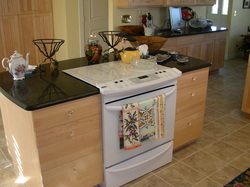
Laminate: Formica is a brand name and has become a generic name for all laminates regardless who manufactured them. It is the least expensive top available and widely used in modular housing and for builders trying to build to a price. It has sharp edges and corners, and the particle board substrate is prone to water absorption and swelling. Once scratched, it can only be replaced, not repaired. Laminate tops will actually subtract from the value of your house on the real estate market. They are harder than ever to get because so few builders are still using them; therefore, their price is rising and quality is falling. We do not build, supply or recommend laminate tops.
Granite: Granite (or stone) comes in a wide variety of colors and types, and the names can change with different suppliers, even if the stone is from the same quarry. Besides being naturally beautiful, stone is smooth, cool to the touch and retains a high polish. Most stone sold locally is from Brazil and arrives through the ports of Miami and Tampa, and hasn't traveled far on the roads, thus saving costs. It is a natural product, and the material's look will change with changes in the quarry it comes from. You can choose your slabs from the local stone yard, and the fabricator will put it aside for your project. Hiding the seams between pieces can sometimes be a problem if the stone has a lot of figure. This can be minimized by a good fabricator. If well sealed when new, stone will not normally absorb stains. Do not leave spilled wine or oils on the surface overnight. Care is usually limited to just wiping with a sponge and drying with a hand towel.
People have asked if stone is hard on your dishes or glassware. We have not experienced this after several years of daily living with stone tops. Stone can cost about 1/3 more than Solid Surface depending on your choice of material. Stone adds the most value to your house on the resale market.
We are in an especially good buyers market for stone here in SW Florida. Since the raw material comes through our local ports, the price is low. In addition, many stone artisans have opened businesses here. Competition is fierce, and prices are stable or lowering in our market while the quality of the installations is high, and rising.
Quartz: Quartz is a man-made product consisting of ground granite (about 90%) mixed with solid surface resin. The surface is hard and takes a polish, but not as high a polish as granite. It is cool to the touch but warmer than solid granite, and the surface does not need to be sealed, even when new. The look is uniform without figure or variation. Quartz is more expensive than stone. It generally costs about 1/4 to 1/3 more than a normal stone top and adds about the same market resale value as natural granite. The uniformity of Quartz can be an asset when there is a large top that requires seams, as they are less visible due to the absence of figure in the material.
Other options...
Marble: Marble is almost never used for countertops due to its softness and cost. I have not seen a new marble countertop installation in years, even in baths.
Wood: This varies with species and finish. It is generally high maintenance, but can be beautiful when used in a rustic setting.
Tile: This is our least favorite countertop. It starts out nice, but there is no good way to maintain the grout lines over time, and they accumulate dirt and grease. The underlying structure must be solid and well supported, and the weight of the sink controlled. The surface finish (glaze) can be easily damaged from ceramic dishes and metal pots. It is inexpensive to install and can add color and fun to a kitchen, but we think its problems outweigh the good points. Keep in mind that our opinions are only that...opinions.
I'll try to rate features of the various available top materials from 1 to 10. As you can see, heat damage resistance varies, as does maintenance and repairability. This table is my own view and does not relate to any other source.
| | | |


 RSS Feed
RSS Feed
